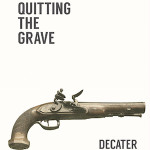How To Beat The Devil In A Writing Contest In Three Easy Steps
Part One of a three-part series entitled, How To Write A Story, A Good Story, And Finally A Great Story.
Imagine you’ve made a string of mediocre decisions that have left you with no choice to save your soul but to challenge the devil to a contest. The fact you’ve found your way to this website suggests that your favored pursuit is most likely some form of writing or storytelling, so you will obviously engage Satan in a writing contest. Whoever writes the better story gets to have your soul.
That’s a lot of pressure. If you do find yourself in that situation, I really hope you’ve read the right tutorials and spent a lot of your free time practicing, because the Devil definitely knows how to spin a yarn. Luckily, you’ve come to the right place.
In my own experience as an aspiring author, going all the way back to grade school, I’ve found that most advice on how to write a good story starts with, “A story must have a beginning, middle, and end.” Unfortunately, this is often nearly the full extant of the advice, especially when it comes to online blogs and writing tutorials. You might be provided with a list of story elements (character development, conflict, setting), most of which are obvious, followed by some do’s and don’ts (show don’t tell, don’t use adverbs) that while true, aren’t very illuminating.
These advice manuals often fall under attention grabbing headlines (8 tips for better writing, how to write the Great American Novel in 13 easy steps) and they promise a lot more than they actually deliver. How many times do we need to be told to practice, practice, practice or that we must find our voice. Perhaps it makes us feel better to read this kind of conventional wisdom, maybe it gives us a temporary surge of motivation, but is it really teaching us anything?
So I’m going to share with you some of my own storytelling advice, and I will do my best to shy away from the trite. Instead, I’ll talk very practically about what constitutes a good story and what things you can do to write one.
But, as with everything outside of a Quentin Tarintino screenplay, we’ll have to start at the beginning.
Step One: What makes something a story?
I know what you’re thinking. Didn’t you just say you weren’t going to fall into the trap of being obvious?
Don’t worry, I’ll keep the beginning brief. The thing is, though, I’ve taught enough creative writing classes to know that especially for beginners, what makes something a story isn’t always obvious, especially if the only guidelines you’ve got to go on is that beginning, middle, and end bit.
It’s really very simple. In order to tell a story, something needs to HAPPEN. There has to be a conflict and a resolution. It may not be a satisfactory conclusion, and the events may not be interesting, but we’re just talking bare minimum here.
Allow me to illustrate with some examples that aren’t a story, and maybe some of you will have the smug expressions wiped off your face (because I have a feeling that you’ll recognize elements of your own writing in them):
Character Descriptions, no matter how detailed, are not stories. A Setting, no matter how interesting or creative, is not a story. The Fictional World you’ve spent weeks planning out is not a story. And most of all, a premise is not a story. You can’t just set up a situation and then leave it at that.
Because most of us probably at least dabble in short fiction, the above scenarios should sound familiar. I’ve read plenty of microfiction that simply describes a situation without ever getting to the action. It’s all set-up and description. I’ve written plenty of pieces like this myself.
Let me be clear, if you are using your short fiction as a writing exercise, it’s perfectly acceptable to ignore these guidelines. I regularly use my 100-word stories as a way to practice all kinds of techniques, whether it be creating interesting characters, toying with exciting scenarios, practicing voice, or even just playing around with style and vocabulary. That’s great. As the Aristotles above might say, practice, practice, practice. As long as you can distinguish between the stories and non-stories, you’re doing fine.
But if your goal is to write an actual story, not just practice a particular technique, then you have to have something happen followed by a resolution. The way to get a reader to engage in your story is to grab their attention, and even more importably, make them want to know what happens next. So next time you sit down to write a story, stop focusing on all the other garbage, and really think about what’s going to happen. I humbly suggest that rather than starting with character building, the scenery building, the world building, and then trying to find the story in it, if you instead focus initially on the action, thinking about some tense moment, and then start fleshing out the who, where, and why from there, you’ll end up with a much tighter narrative.
At the very least, we can be sure you will have a narrative.
Before moving on, why don’t you practice with a 100-word story of your own. Make sure there’s a clear conflict and a resolution. If you like, put it in the comments, or submit it to A Story In 100 Words, and I’ll post it to the site.
Next, we’ll get to what you really want to read about. How do you write a GOOD story. I promise, all the interesting stuff will be in part two.
 Check out Decater's new novel, available now at Amazon. Plus, don't forget his earlier books: Ahab's Adventures in Wonderland and Picasso Painted Dinosaurs.
Check out Decater's new novel, available now at Amazon. Plus, don't forget his earlier books: Ahab's Adventures in Wonderland and Picasso Painted Dinosaurs.



